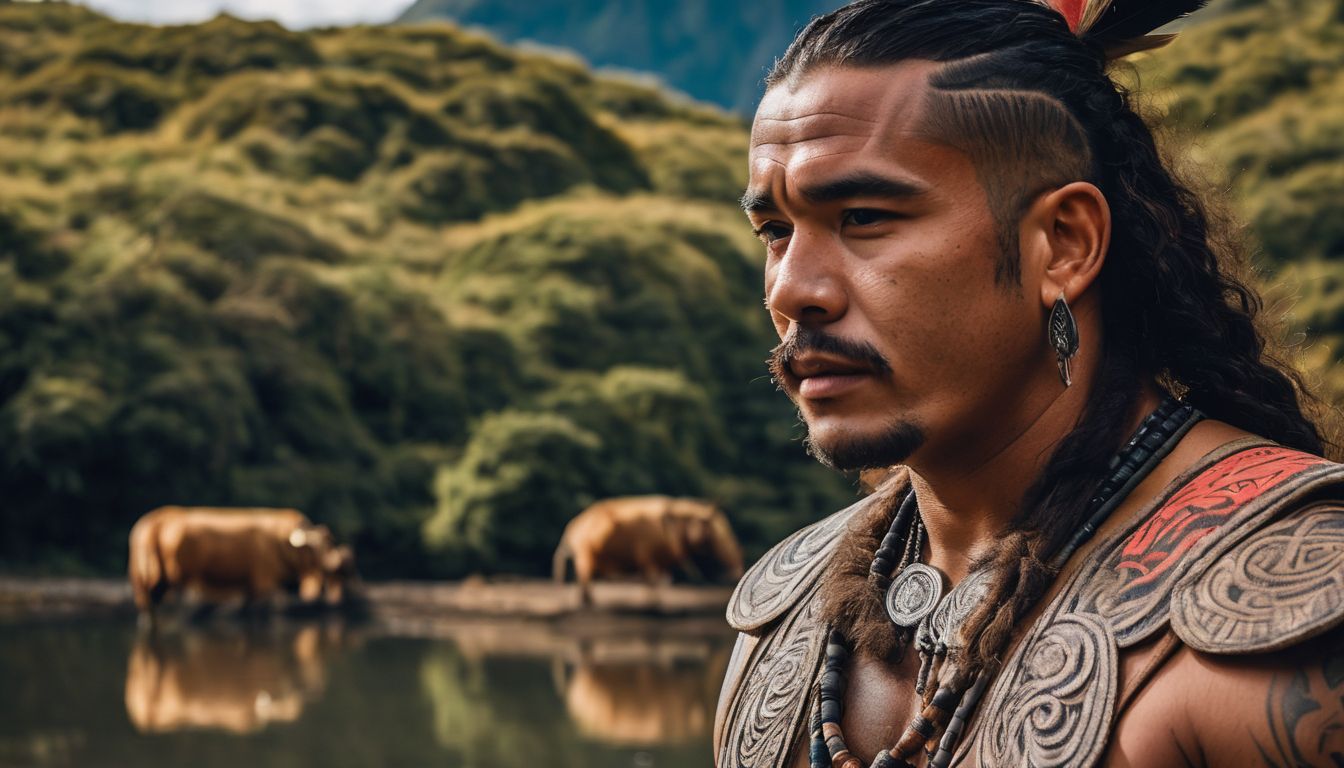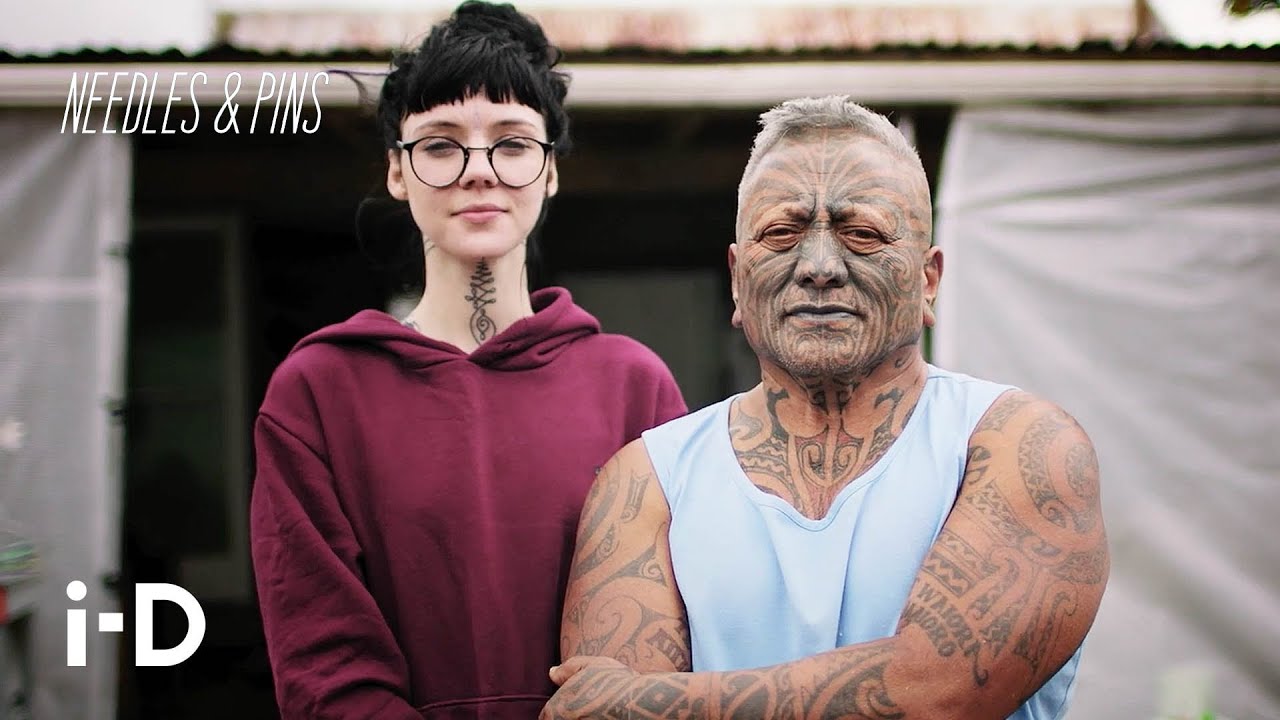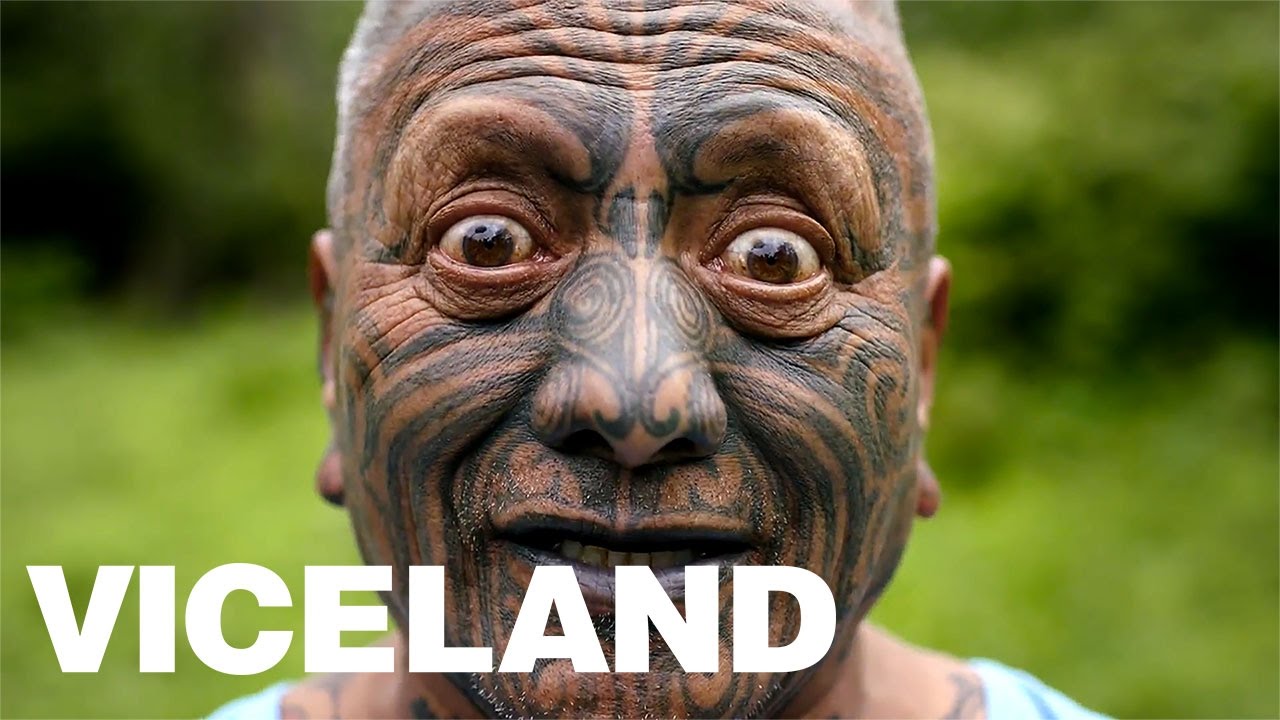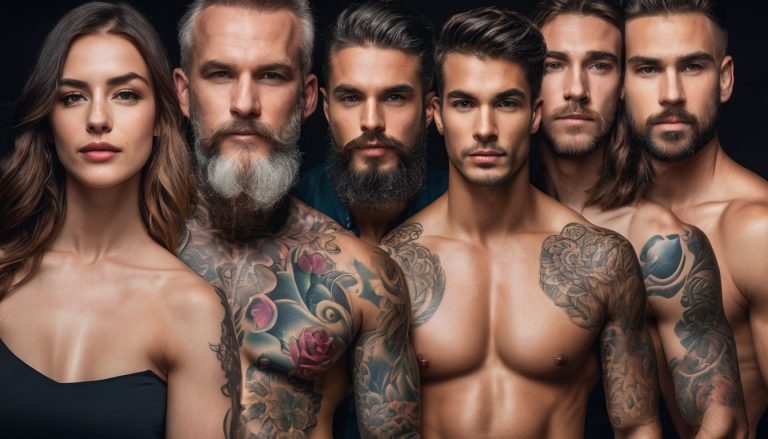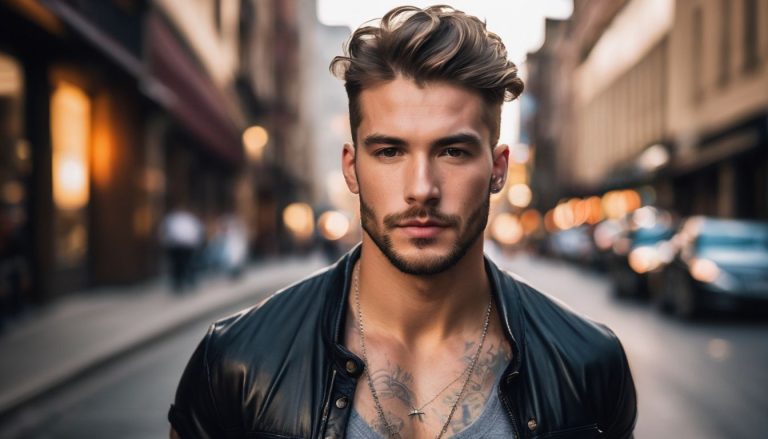Exploring the Cultural Significance of Maori Face Tattoos: Tā Moko
Create your own unique tattoos and art for your home
Many people see striking tattoos on faces and wonder about their origins. Tā Moko, the facial tattooing of the Māori, carries a history rich with spiritual depth and social importance.
This article illuminates why these markings are far more than just skin-deep artistry, revealing identity and heritage to those who wear them. Discover the story behind each line and curve.
Key Takeaways
- Tā Moko is a traditional form of Māori facial tattooing that signifies identity, heritage, and social status using intricate designs with deep-rooted cultural meanings.
- Traditional tā moko was applied with chisels and natural inks, creating grooved patterns on the skin. The process was both spiritual and physically demanding, demonstrating commitment to cultural traditions.
- The art has experienced a resurgence after being suppressed during European colonization. It’s now seen as a symbol of pride and connection to ancestry among the Maori people, though its adoption by non-Maori individuals raises debates about cultural appropriation.
- Key symbols in tā moko include the Koru (life), Manaia (guardian spirit), Hei Matau (prosperity), among others, each holding specific significance within Māori culture.
- While tā moko is historically significant for Māori identity and community status, it also influences modern tattoo practices worldwide through its unique design elements.
History and Traditions of Tā Moko
Before the arrival of Europeans, tā moko was a traditional form of tattooing for the Māori people, using chisels and pigment to create intricate facial markings. The practice underwent significant changes with European colonization and has since evolved into contemporary use, even extending to non-Māori individuals.
Pre-contact practices
Long before European explorers set foot on New Zealand, the Maori people developed Tā Moko as a revered form of expression and identity. High-ranking individuals underwent these facial markings to emphasize their status, genealogy, and tribal connections.
Each tattoo told a unique story of the wearer’s accomplishments, experiences, lineage, and social position within the community.
Māori artists used chisels made from albatross bones and natural inks to carve the skin with intricate designs. Unlike superficial skin tattoos common today, Tā Moko was etched into the skin creating grooves that conveyed deeper symbolism.
This sacred art required great skill and knowledge passed down through generations. The process was a transformative rite marking key milestones in an individual’s life journey—effectively weaving personal narratives directly into their visage for all to see.
Instruments used
The instruments used for traditional Tā Moko were typically made of bone, wood, or stone. These tools included combs with serrated edges that were used to tap pigment into the skin.
The chisel-like uhi, carved from albatross bone or other durable materials, was employed to create the grooves in the skin. The process of creating Tā Moko designs was intricate and required skillful precision from the tattoo artist.
Each tool was purposefully crafted to ensure that the design not only communicated social status and identity but also maintained spiritual significance.
Changes with European colonization
European colonization brought significant changes to the traditional practice of Tā Moko among the Māori people. The arrival of European settlers led to a decline in the use of traditional chisels for Tā Moko, as they introduced metal tools which allowed for faster and more precise tattooing.
Additionally, with the spread of Christianity, there was a period when Tā Moko faced suppression and disapproval from colonial authorities. This affected its cultural significance and led to a decline in its practice among some Māori communities.
Contemporary usage
After enduring a decline due to European colonization and missionary influence, Tā Moko has experienced a resurgence in contemporary Maori culture. The modern usage of Tā Moko extends beyond mere cosmetic enhancement; it has become a symbol of cultural pride and identity for the Maori people.
In addition to its traditional significance, many Maori individuals are choosing to receive Tā Moko as a way of reconnecting with their indigenous roots and asserting their cultural heritage.
Furthermore, non-Maori individuals are increasingly seeking out authentic Tā Moko designs from skilled practitioners as a means of honoring and respecting the rich traditions of the Maori people while also acknowledging the unique cultural significance behind each individual’s markings.
Use by non-Māori
Contemporary usage of Tā Moko has seen an increasing interest and adoption by non-Māori individuals, as a form of honoring and respecting the rich cultural heritage of the Māori people.
Non-Māori who choose to receive a Tā Moko acknowledge its significance as a representation of courage, nobility, and tribal customs. The decision to wear Tā Moko is often accompanied by a deep respect for indigenous art forms and serves as a way for non-Māori individuals to express appreciation for the cultural identity and traditions of the Polynesian community.
Cultural Significance of Tā Moko
Tā Moko is a symbol of pride and courage in Māori culture, with the head and face being especially important. It also signifies social status and prestige within the community.
Symbol of pride and courage
A symbol of pride and courage, Tā Moko is deeply respected within Māori culture. It represents an individual’s honor, resilience, and connection to their ancestral heritage. Each intricate design etched on the face tells a unique story of the wearer’s strength and prestige.
Tā Moko signifies an enduring commitment to upholding one’s identity and social standing within the community. This traditional facial art form embodies dignity, bravery, and a profound sense of cultural inheritance that has been passed down through generations.
Importance of the head and face in Māori culture
The head and face hold immense significance in Māori culture. These areas are considered the most sacred parts of the body, where Tā Moko, the traditional facial tattooing, is exclusively reserved.
Historically, it was adorned by members of high social status as a symbol of nobility and prestige within the community. Consequently, Tā Moko served as a visual representation of an individual’s tribal affiliations, lines of descent, and personal identity.
As such, it became an integral part of asserting one’s place within Māori society.
Tā Moko also embodies cultural pride and connection to Polynesian heritage for those who bear them on their faces. The distinctive designs express familial ties while functioning as a form of storytelling through intricate patterns that convey meanings like strength, prosperity, and career paths.
Connection to social status and prestige
Tā Moko holds significant connections to social status and prestige within Māori culture. Historically, the facial tattooing was exclusively reserved for individuals of high rank and noble heritage, serving as a visible symbol of their standing in society.
The full-face Moko conveyed not only the wearer’s tribal affiliations but also their lines of descent, communicating a sense of identity and belonging within the community. Furthermore, Tā Moko was a mark of distinction for men, signifying their status and responsibilities within the tribe.
The intricate designs encompassed meanings that reflected personal achievements, family lineage, and societal roles. As such, Tā Moko not only served as an expression of cultural pride but also highlighted the individual’s esteemed position within Maori society.
The Art of Tā Moko
The art of Tā Moko involves intricate and sacred designs that hold great significance in Māori culture. The process is known to be painful and has influenced modern tattooing practices around the world.
Complexity and sacredness
Tā Moko is distinguished by its intricate patterns and holds immense sacredness in Māori culture. The process of Tā Moko involves deep grooved lines on the skin, showcasing the complexity and depth of this traditional art form.
Each unique design signifies not only personal identity but also connections to tribal heritage, social status, and spiritual beliefs. The ritualistic nature of Tā Moko reflects its sacred essence, as it is considered a deeply spiritual and cultural practice that carries immense significance for both the individual and their community.
The intricate designs of Tā Moko are more than just body adornments; they represent an individual’s journey, wisdom, and lineage. This complex symbolism reflects the deeply rooted connection between each person’s identity and their cultural heritage while honoring the tradition’s timeless sacredness.
Painful process
Transitioning from the complexity and sacredness of Tā Moko, it’s important to acknowledge that the process of receiving these facial tattoos is not without its challenges. Traditionally, Tā Moko was a painful and laborious procedure, as it involved carving intricate designs into the skin using chisels made of bone or metal.
The deep grooved lines left by these tools resulted in both physical pain and lasting scars on the individual’s face.
The process of Tā Moko involves not only enduring physical discomfort but also represents a spiritual journey for the person receiving the tattoo. Enduring this intense pain demonstrates one’s commitment to their cultural identity and symbolizes their willingness to uphold traditions that have been passed down through generations.
Influence on modern tattooing
Transitioning from the painful process of Tā Moko, its influence on modern tattooing has been substantial. The intricate designs and unique techniques of Tā Moko have inspired contemporary tattoo artists, influencing the evolution of Polynesian tattooing traditions.
These influences are evident in the incorporation of traditional Maori design elements and symbolism into modern tattoos, highlighting the cultural significance and identity symbolism found in tā moko.
The use of deep grooved lines and complex patterns reminiscent of Tā Moko can be seen in various forms of contemporary body art. Furthermore, as people continue to embrace diverse cultural symbols and meanings in their tattoos, the influence of Tā Moko extends beyond Polynesian communities.
Design Elements and Meanings
Explore the traditional designs, common symbols, and their meanings within Maori face tattoos, known as tā moko. To learn more about the cultural significance of these intricate designs, continue reading!
Traditional designs
Traditional designs of Tā Moko feature intricate patterns and symbols that hold deep cultural significance within Māori tradition. These designs are unique to each individual and convey various meanings, such as family lineage, prosperity, strength, and even the career path of the person bearing it.
The use of spirals, curves, and geometric shapes in these traditional designs reflects the interconnectedness of all living things and their relationship with the spiritual world. Each element is carefully chosen to reflect the wearer’s identity and tribal affiliations while honoring their heritage.
These traditional designs are not merely decorative; they serve as a visual narrative representing an individual’s journey through life, trials endured, victories achieved, and connections established within their community.
Common symbols and their meanings
Tā Moko designs incorporate a wide range of symbols, each carrying its own unique significance. These symbols play a crucial role in expressing the personal and cultural narratives of the wearer.
- Koru: The unfurling fern frond represents new life, growth, strength, and peace.
- Manaia: A guardian spirit, typically depicted with the head of a bird, the body of a man, and the tail of a fish; it symbolizes protection and balance between the sky, earth, and sea.
- Tiki: A human-like figure with large eyes and hands clasped to its chest; it embodies fertility, clarity of thought, loyalty, great knowledge, and deep respect for ancestors.
- Enata: This symbolizes people or community; it conveys unity amongst individuals or groups within a community as well as connections between generations.
- Pikorua (Twist): It signifies the bond between two people – whether it be friends or eternal love – through friendship and loyalty.
- Hei Matau (Fish Hook): Traditionally associated with prosperity from fishing; this symbol represents abundance, wealth, good health, determination in overcoming obstacles.
- Moko: The term refers to personal identity as expressed through Tā Moko designs; signifying that these designs uniquely represent one’s individuality and connections to their roots.
- Rito (Two outer rings): Symbolizing parenthood – depicting parent’s nurture care for their children until they grow up or leave home.
Examples of significant designs
Some traditional Tā Moko designs include the “Koru,” representing new life, growth, and strength. Another noteworthy design is the “Manaia,” embodying spiritual guardianship and protection.
Additionally, the “Puhoro” symbolizes determination and overcoming challenges, while the “Whakapapa” signifies ancestry and connection to one’s roots. Each design is unique to the individual it adorns, telling a deeply personal story through intricate patterns rich in cultural significance.
These designs exemplify how Tā Moko captures a person’s identity while honoring their heritage with meaningful symbols that carry centuries of tradition.
Controversies and Debates Surrounding Tā Moko
The use of Tā Moko by non-Māori individuals and the controversies surrounding cultural appropriation have sparked debates within both Māori and non-Māori communities. While some argue for respect and understanding, others question the ethical boundaries of adopting this sacred tradition.
Acceptance by non-Māori
Non-Māori individuals have increasingly embraced Tā Moko, recognizing its cultural significance and artistic value. Many people from diverse backgrounds seek Tā Moko as a way to show respect for Māori culture and connect with the traditions of New Zealand’s indigenous people.
This growing acceptance reflects a broader appreciation for the beauty and meaning behind this sacred form of facial adornment, transcending cultural boundaries.
Moving forward to “Cultural appropriation controversies”.
Cultural appropriation controversies
Non-Māori individuals adopting Tā Moko designs have sparked cultural appropriation debates. This practice has raised concerns within the Māori community, as these tattoos hold deep spiritual and cultural significance.
The controversy stems from the fear of trivializing or disrespecting the sacred art form through non-indigenous use. Such appropriation can undermine the historical and social importance of Tā Moko to the Māori people.
The issue of cultural appropriation surrounding Tā Moko reflects broader societal discussions about respecting indigenous traditions and symbols. As tattoo trends spread globally, it’s crucial to recognize and honor the origins and meanings behind traditional practices like Tā Moko.
Perspectives from Māori and non-Māori individuals
Māori individuals view Tā Moko as an integral part of their cultural identity, representing ancestral connections and personal stories. For them, it is a symbol of honor, pride, and resilience that carries deep spiritual significance.
It’s a way to visibly express tribal affiliations and social status while connecting with their rich heritage. On the other hand, some non-Māori people have come to appreciate Tā Moko for its artistic value and unique cultural significance.
However, there are debates around the appropriation of this sacred tradition by those outside of the Māori community.
Conclusion
In conclusion, Tā Moko serves as a powerful symbol of cultural pride and identity within the Māori community. Its rich history and significance continue to play a vital role in shaping modern perceptions of body art and individual expression.
The complexities and meanings behind Tā Moko designs provide an insight into the deep-rooted traditions that have endured over centuries. As discussions surrounding its appropriation evolve, understanding the importance of Tā Moko within its cultural context remains essential for fostering respect and appreciation.
FAQs
1. What are Maori face tattoos called?
Maori face tattoos are known as Tā Moko and they represent a sacred body art tradition in the Maori culture.
2. Why is Tā Moko important to the Maori people?
Tā Moko holds deep cultural significance for the Maori, symbolizing personal identity, social status, and history within their community.
3. Does each Tā Moko have a special meaning?
Yes, every Tā Moko includes unique patterns that carry different meanings related to family background, tribal affiliations, and individual achievements.
4. Can anyone get a traditional Maori face tattoo?
Traditionally, receiving a Tā Moko is reserved for those of Maori heritage who understand its symbolism and respect its cultural importance within their community.

